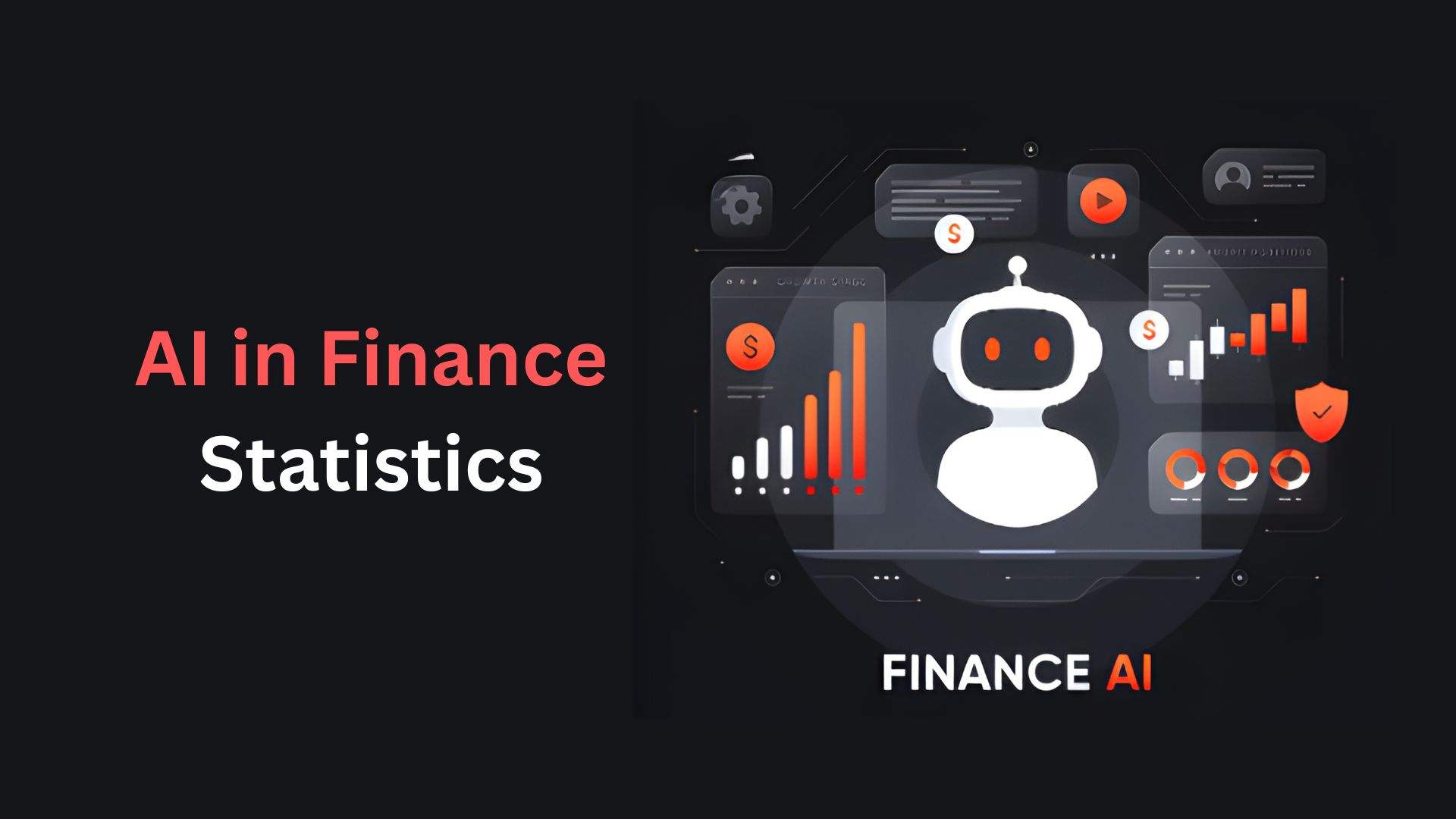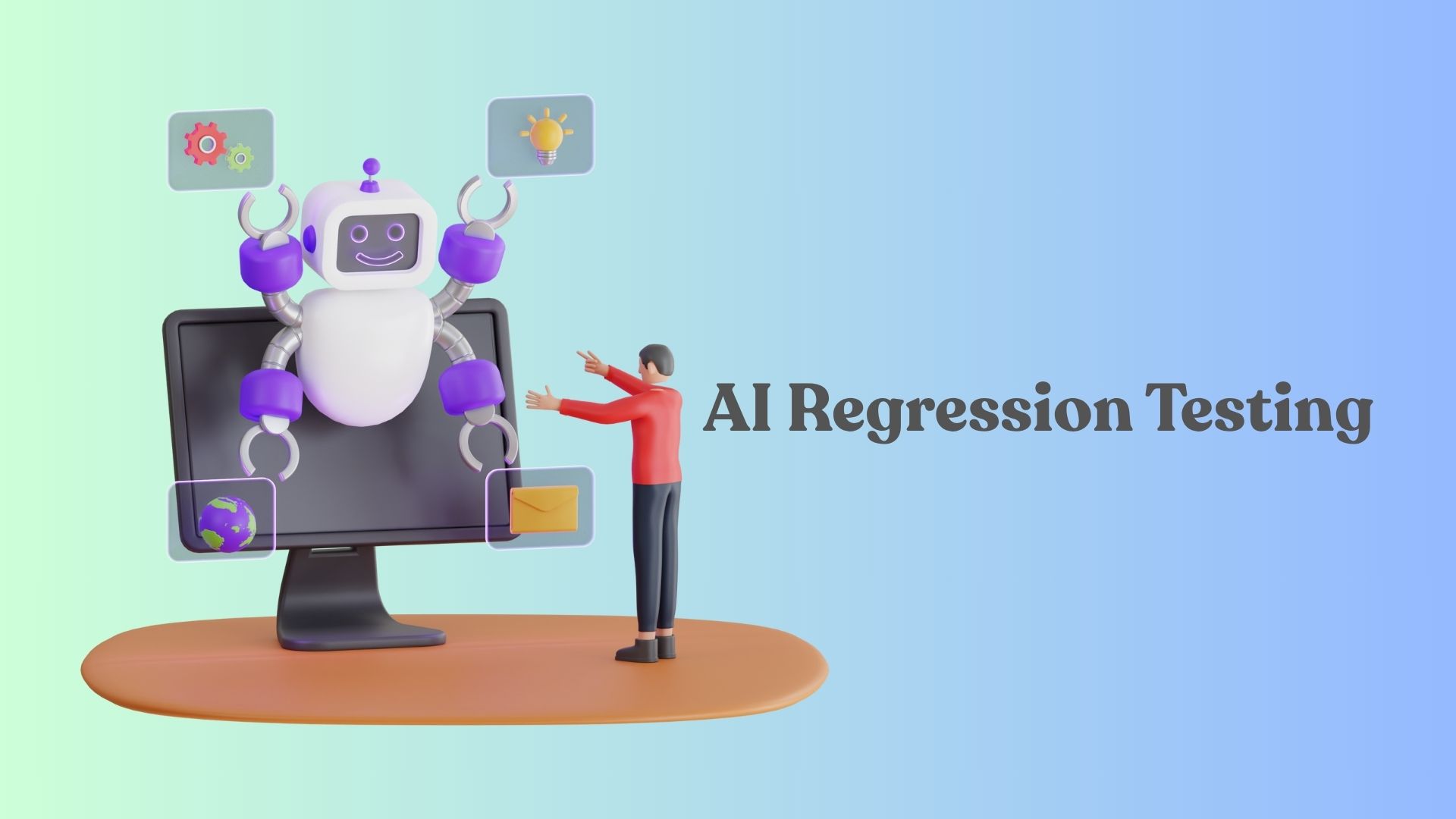Robotaxi Statistics and Facts
Updated · Feb 03, 2025
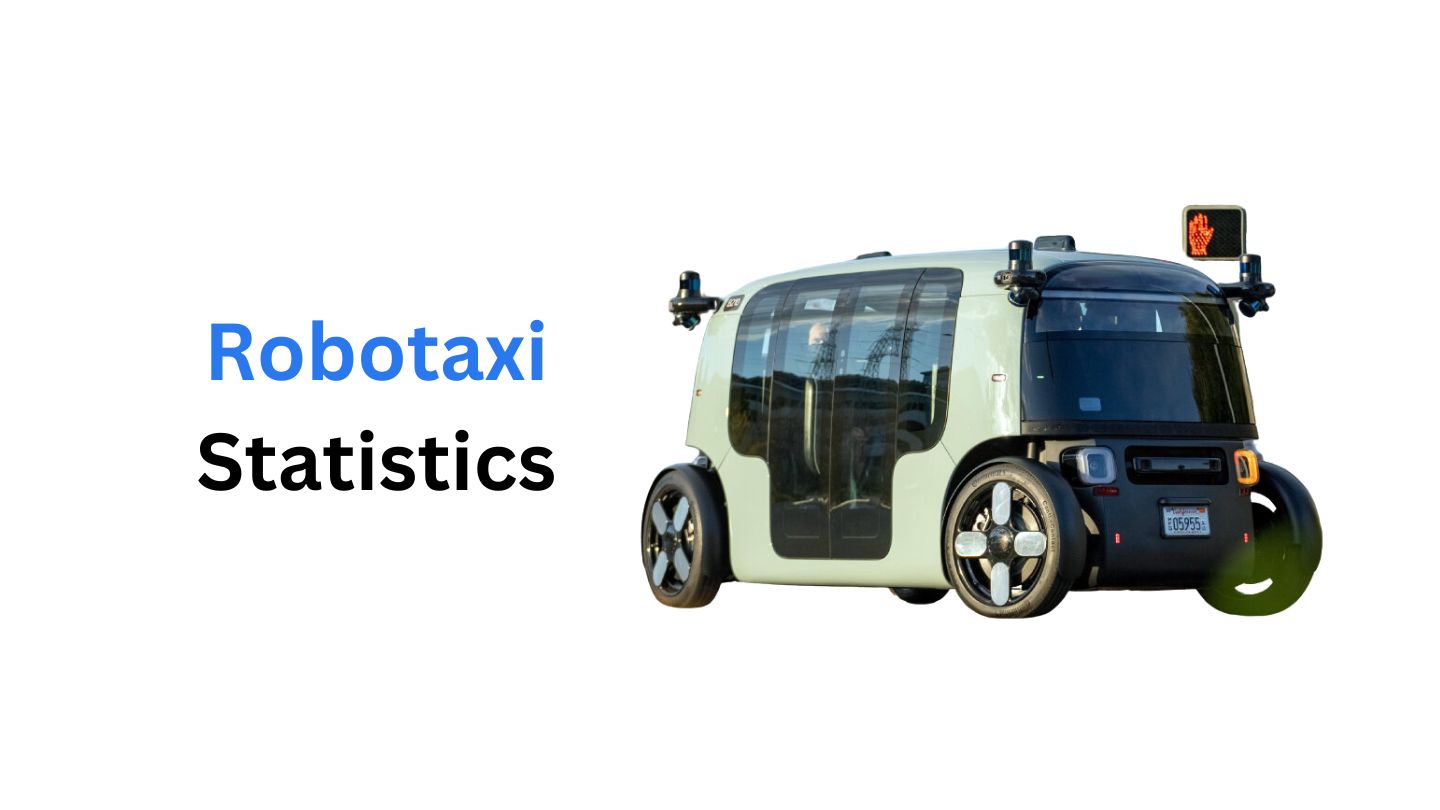
Table of Contents
Introduction
Robotaxi Statistics: In 2025, the robotaxi industry experienced significant growth, marking a pivotal year for the development of autonomous transportation. Robotaxis, or self-driving taxis, operate without a human driver from the moment a passenger books a ride until they exit the vehicle. These vehicles utilize artificial intelligence, sensors, and machine learning to navigate and transport passengers.
Robotaxis are poised to transform urban mobility by providing safer, more efficient, and more economical transportation options. This article focuses on robotaxi statistics and the impact of their growth.
Editor’s Choice
- The global robotaxi market size was approximately USD 1.76 billion in 2022 and is projected to grow to USD 98.59 billion by 2030, with a CAGR of 65.3%.
- By 2030, robotaxis are expected to account for 20-25% of shared mobility passenger kilometres in tier-one cities in China.
- Shared mobility passenger kilometres in China are estimated to increase from 177 billion in 2020 to 450 billion by 2030.
- Robotaxis are anticipated to cover 5% of the shared mobility market in China by 2030.
- By 2025, 60% of all new cars sold globally will be Level 2 autonomous cars.
- By 2030, Level 3 and Level 4 autonomous cars are expected to account for about 8% of new car sales.
- The robotaxi industry’s revenue reached USD 1.2 trillion and is expected to comprise 63% of revenue generation across various business lines.
- Robotaxis are projected to contribute to 86% of total EBITDA, amounting to USD 440 billion.
- The enterprise value of robotaxis is expected to reach USD 8.2 trillion, representing almost 88% of total industry worth.
- Tesla demonstrated over 3.2 million miles per accident on Full Self-Driving (FSD) in 2023, outperforming human-driven Teslas at 588,000 miles and Waymo at 476,000 miles.
- Cruise’s robotaxi system recorded only 43,000 miles per accident in 2023, while the national average for human-driven cars is around 192,000 miles.
- Major industry players include General Motors, Toyota, Nissan, Volkswagen, Ford, Tesla, Waymo, and Baidu.
- Various manufacturers, such as Waymo, Tesla, and Baidu, have been expanding their robotaxi fleets.
- Plans are underway to develop 1,000 driverless taxis within three years by a company alongside Didi, WeRide, and Pony.ai, which have publicly announced expansions.
Facts About Robotaxi
- In 2019, about 31 million vehicles were considered to be automated somewhere around the world. This number is predicted to cross 54 million by 2024.
- Despite very optimistic robotaxi makers’ claims, fully autonomous taxis might remain years away. One of the big obstacles is that the technology needed to make fully autonomous vehicles a common reality is not yet advanced enough.
- Yet manufacturers are fitting new vehicles using available technologies to provide some automation with partial capability toward specific tasks.
- Vehicles classified as Level 0 may provide only limited automation and work as driver assistance in certain conditions, while Level 5 is for fully autonomous vehicles, able to operate without any human involvement.
- By 2025, almost 60% of all new cars sold globally will be fitted with Level 2 autonomy.
- Robotaxi statistics reveal that by 2030, Level 2 is expected to command an 83% share of market sales; however, around 8% of new sales will likely consist of Level 3 and Level 4 vehicles.
- The robotaxi industry has attracted the attention of many car manufacturers, technology firms, and start-ups.
- Companies active in the sector include General Motors, Toyota, Nissan, Volkswagen, Ford, and Tesla.
- Many companies are either forming partnerships with or acquiring smaller companies to gain access to technological know-how while finding the development of autonomous taxis to be extremely challenging.
- The industry is becoming gradually consolidated. For instance, General Motors purchased the start-up Cruise in 2016, and in 2021 Toyota bought Lyft’s self-driving car division. Ford and Volkswagen have invested heavily in another start-up, Argo AI.
Global Robotaxi Market Size
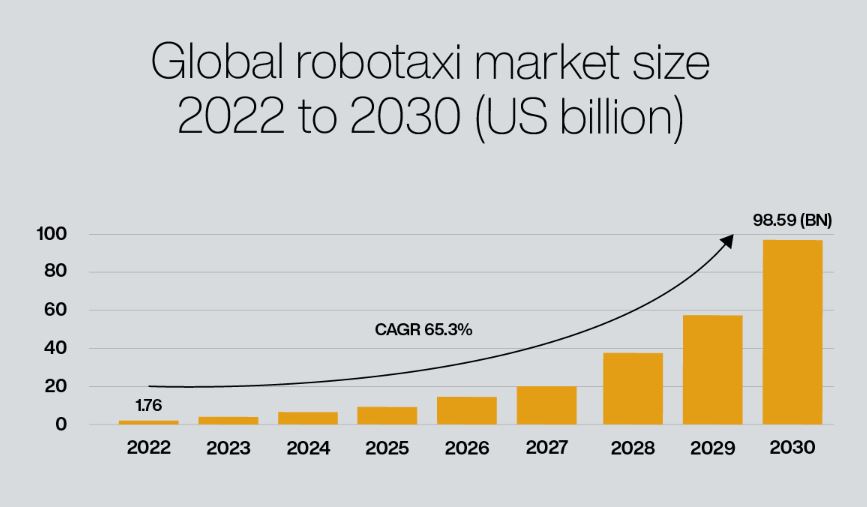
- The global market for robotaxis has enjoyed rapid growth and is poised for extensive expansion in the coming years.
- In 2022, the market was valued at approximately US$1.76 billion.
- This is the time when the industry has initially started developing, and companies are largely focused on research, pilot programs, and limited commercial deployments.
- With each subsequent technological advancement in AI, sensor technology, and autonomous driving algorithms, the market has skyrocketed in terms of valuation.
- Robotaxi statistics state that the global robotaxi industry is estimated to reach an astounding US$98.59 billion by 2030. This growth, representing a 65.3% CAGR from 2022 to 2030, places it as one of the fastest-growing segments of the transportation space.
- There is a drastic upscaling in the market due to factors such as increasing requirements to have low-cost solutions for urban mobility, favourable regulations for autonomous vehicles, and advancement in vehicle automation.
- By removing the costs of human drivers, robotaxis lowers operational costs and allows lower prices for consumers.
- Furthermore, as autonomous fleets begin to implement more electric vehicles, the cost efficiency of the companies assembling robotaxis and their environmental friendliness will be enhanced.
- In a nutshell, the global robotaxi market will serve as a game changer for urban mobility, and its hyper-growth is further evidence in support of a transition to fully autonomous mobility solutions in the coming years.
Cities Where Robotaxi Are Available
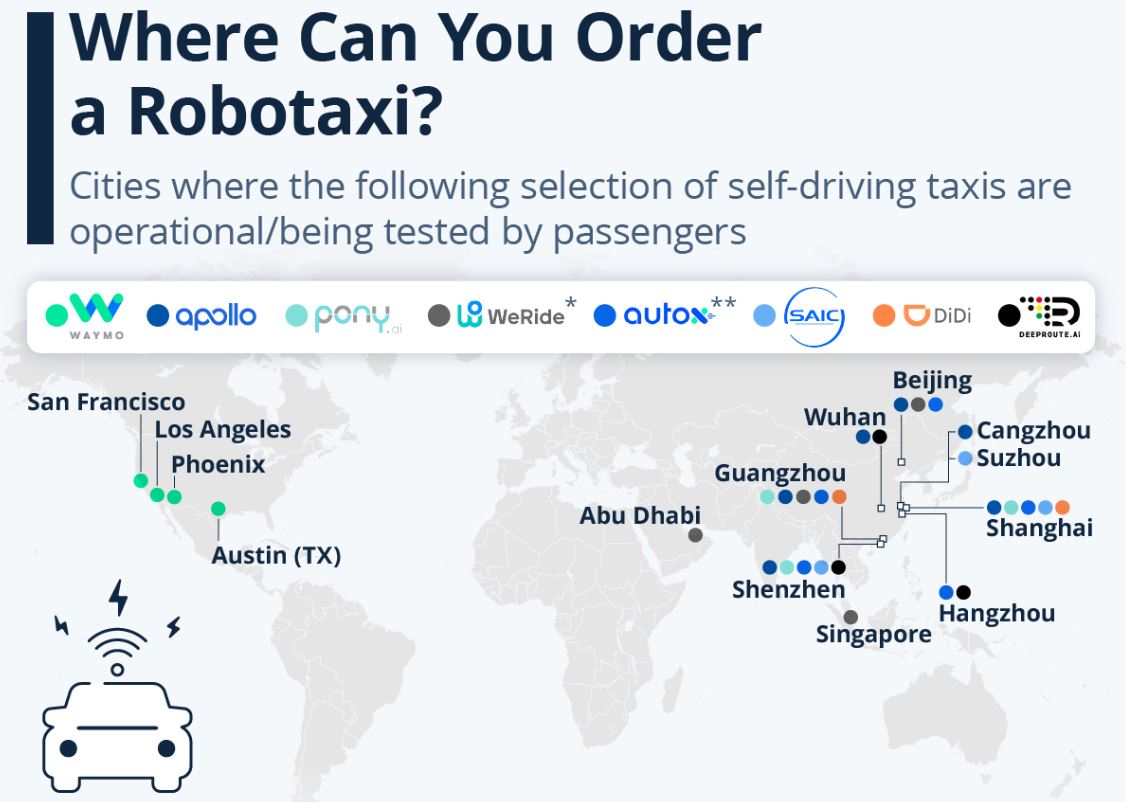
- While self-driving cars are a reality, they currently pose a challenge for society largely with their robotaxi services.
- With ethical and safety issues in consideration, recent accidents, including a robotaxi involved in the crash in San Francisco, have raised the level of concern in the heads of both the lawmakers and the public.
- Following the October incident, General Motors’ Cruise suspended operations in six U.S. cities.
- Meanwhile, a rival, Waymo, a subsidiary of Alphabet, is continuing limited driverless taxi services in San Francisco, Los Angeles, Phoenix, and newly Austin, Texas. Another operator.
- Motional ended its service in Las Vegas in May. In China, robotaxis and even self-driving buses are gaining traction as several companies expand fleets in competition for market share.
- Robotaxi statistics state that the major player, Baidu’s Apollo Go, currently has about 400 robotaxis on the roads in Wuhan, and public trials and commercial services have also been carried out in Guangzhou, Shenzhen, Shanghai, and Beijing, with select companies extending their operations to smaller cities where the trial period began.
- Although ride tests were early on free and application-based, robotaxi fares in China have already become a fuel for friction for traditional taxi drivers.
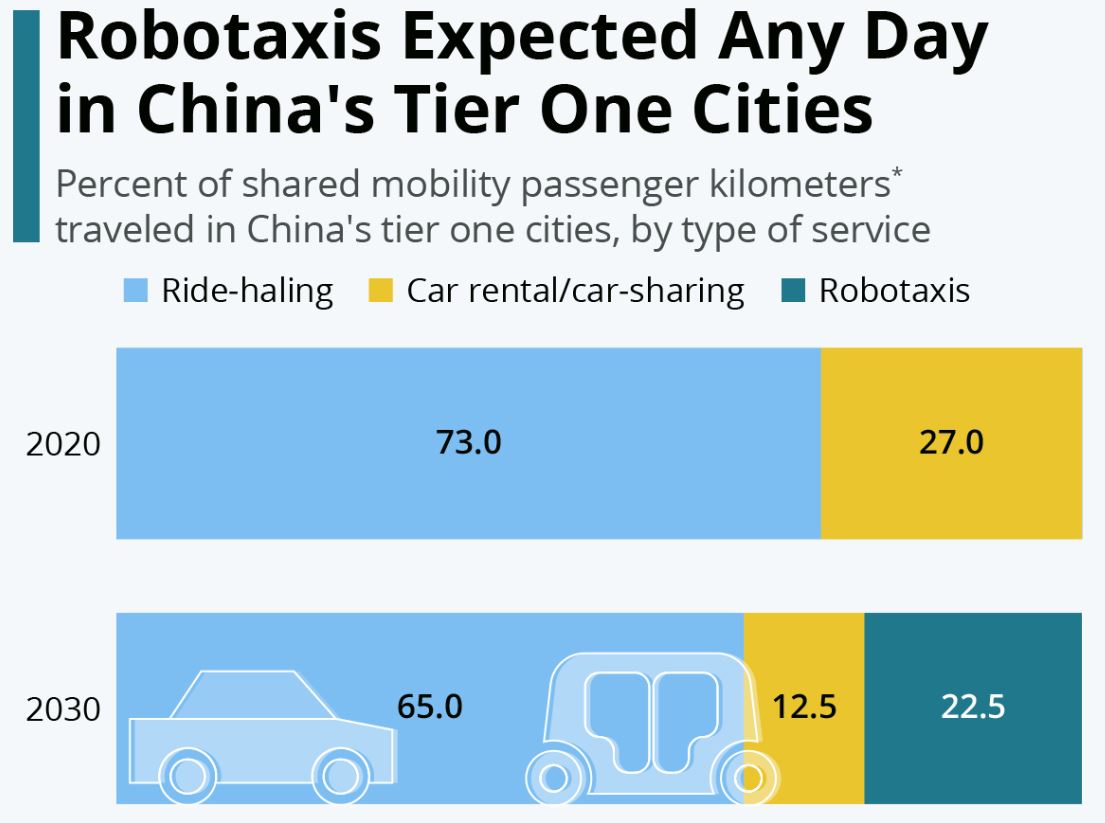
- Robotaxi pilot tests have been rolled out in some of China’s tier-one cities, mainly Beijing and Shanghai. Although still alien to many, it is anticipated that robotaxi services shall multiply across major metropolitan cities of the land.
- Autonomous taxi estimates from McKinsey & Company suggest that perhaps in the coming ten years, autonomous taxis would account for about 20 to 25% of all passenger kilometres travelled by shared mobility within these cities.
- To the extent that robotaxi services increase market share, so shall other means of transportation-be it traditional ride-hailing/ridesharing or car rentals-fare badly. Yet, demand for shared mobility in China continues to rise.
- Robotaxi statistics reveal that the passenger kilometres with respect to shared mobility would shoot from 177 billion in 2020 to over 450 billion by way of 2030, thus allowing for different modes to coexist.
- By 2030, robotaxis will contribute approximately 5% of total kilometric consumption for shared mobility in China.
- This fiercely contested space has witnessed most of the largest tech companies in China come into play. Baidu, the other, which cooperates with manufacturers of autonomous cars, has committed to rolling out 1,000 driverless taxis within three years.
- In the fierce competition in Guangzhou, another tier-one city, startups like WeRide-a.k.a. working with Nissan and Pony.ai, are putting their robotaxi fleets to the test in preparation for wider deployment.
Robotaxi Finacial Statistics
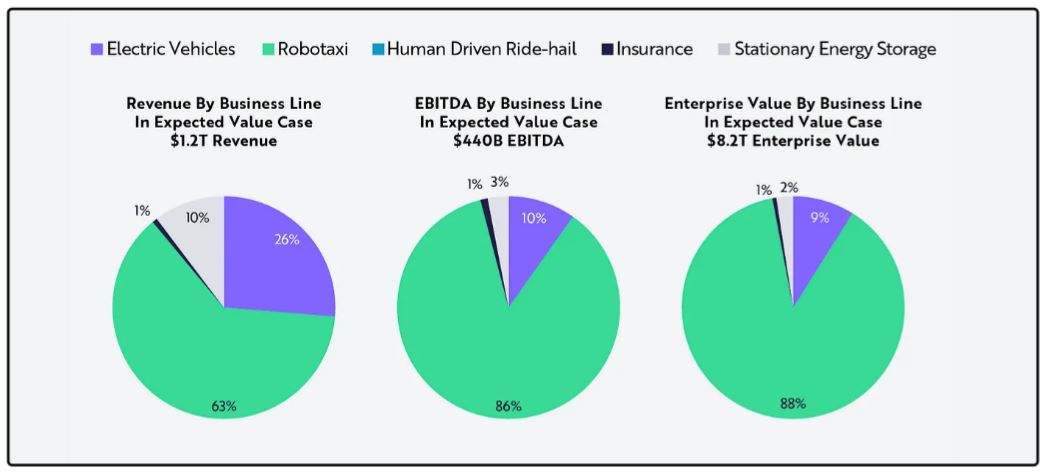
- As per the projected robotaxi statistics, the robotaxi segment generates most of the revenues, profits, and even enterprise value.
- All business lines are expected to generate a total of US$1.2 trillion in revenue.
- Among the other segments, robotaxis is expected to generate revenue shares with the largest percentage, with an estimated contribution of 63% to total revenue.
- Electric vehicles contribute 26%, and stationary energy storage and insurance make up the rest at 10% and 1%, respectively.
- The importance of robotaxis can be gleaned even more while looking at profitability using EBITDA since out of US$440 billion estimated total EBITDA, robotaxis account for an astounding 86%, meaning they have a potential for high-margin operations.
- Electric vehicles then account for 10%, stationary energy storage for 3%, and insurance for a mere 1%.
- Lastly, again, in terms of enterprise value, this refers to the value of the entire business.
- Again, the robotaxis is dominant, with the total enterprise value projected at US$8.2 trillion, and the robotaxis accounts for 88%, thus indicating its financial viability in the long term.
- Electric vehicles represent about 9% of that value, stationary energy storage 2%, and insurance 1%.
Robotaxi Miles Driven Per Accident Across Different Driving Modes
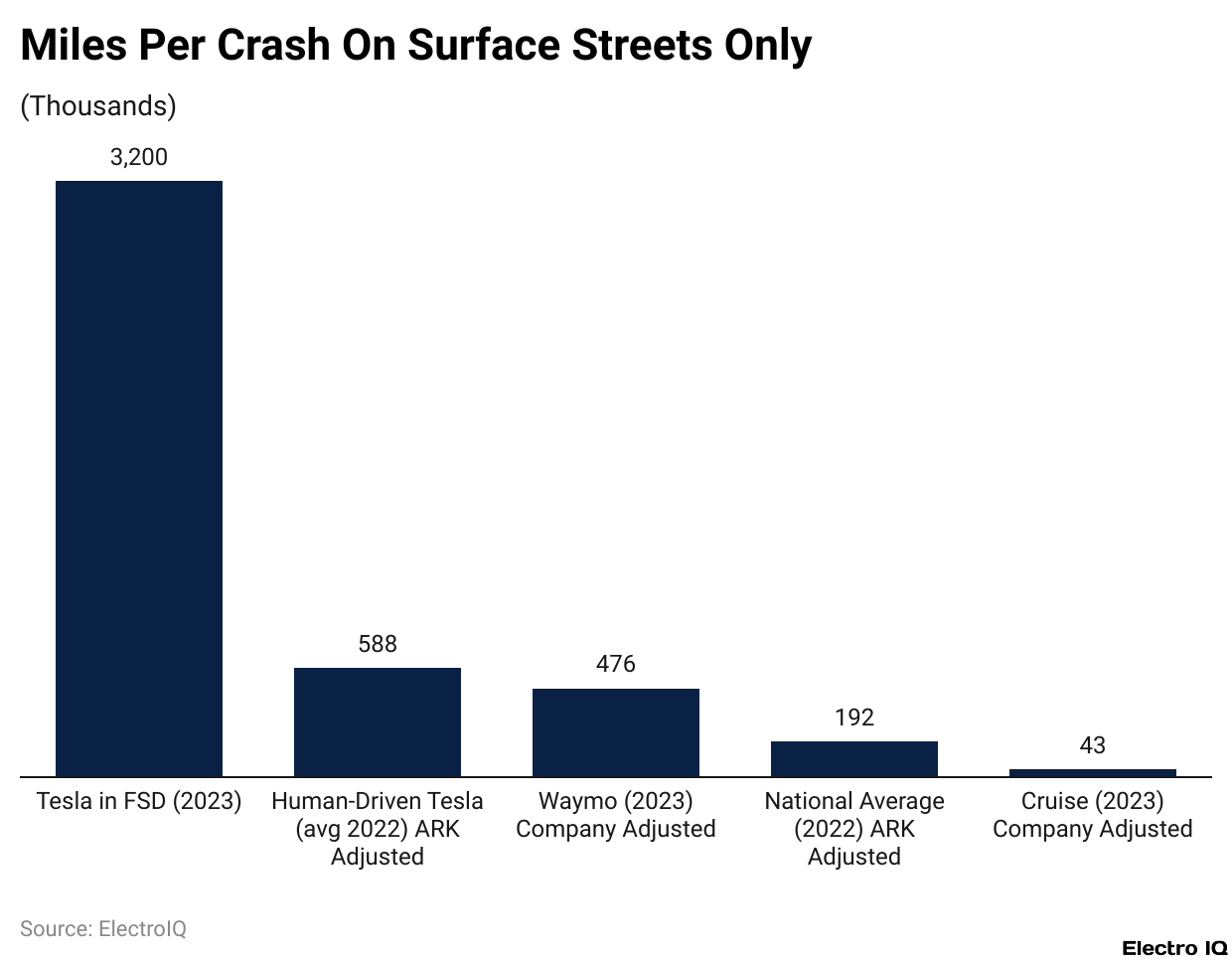
- Robotaxi statistics compare the crash rates in miles driven per accident across various driving modes, including Tesla’s Full Self-Driving (FSD) mode, human-driven Teslas, and autonomous services like Waymo and Cruise.
- In 2023, Tesla vehicles in Full Self-Driving (FSD) mode were said to provide the safest form of transport with accident rates of approximately 3.2 million miles or 3,200 thousand miles per accident. This greatly demonstrates how much Tesla’s autonomous systems prevent accidents compared to human drivers.
- For human-driven Teslas, an average of 588,000 miles was driven per accident in 2022, as adjusted by ARK Invest. This means while human-driven Teslas are still safer than the national average for the crash, they are way below the FSD system of Tesla concerning safety.
- According to Waymo-adjusted data, they had one accident every 476,000 miles in 2023. This is worse than the performance of human-driven Teslas but indicates that Waymo’s self-driving technology is still improving but has not yet reached Tesla’s FSD level.
- The national average for all vehicles in 2022, as adjusted by ARK Invest, stood at 192 thousand miles per accident. This represents the general accident rate for human-driven vehicles in the U.S.
- It highlights how both Tesla’s FSD and human-driven Teslas seem to outperform the overall national safety standard.
- Cruise, another autonomous driving company, reported only 43 thousand miles per accident in 2023, making it the least safe among the listed options. This suggests that Cruise’s self-driving technology may still face significant challenges in curbing accidents when compared to competitors such as Tesla and Waymo.
Conclusion
As per the robotaxi statistics, the robotaxi market signifies a groundbreaking evolution in urban transportation, providing a promising solution to challenges like congestion, emissions, and accessibility. With continuous advancements in autonomous technology, robotaxis is now set to redefine mobility for the future with state-of-the-art AI, advanced sensor systems, and electric propulsion.
The rapid advancement of the industry is due to a convergence of sustainability, demand for efficient transport solutions, and increasing urbanisation of cities around the globe.
FAQ.
In 2022, the global robotaxi market size was valued at 1.76 billion dollars, while the revenue growth expectation for 2030 is pegged at 98.59 billion dollars, with a CAGR of 65.3%.
Some of the major players include General Motors, Toyota, Nissan, Volkswagen, Ford, Tesla, Waymo, and Baidu, and other startups like WeRide and Pony.ai. Waymo, Tesla, and Baidu are actively growing their fleets of robotaxis.
Waymo currently operates in San Francisco, Los Angeles, Phoenix, and Austin in the U.S. While Apollo Go, Baidu operates about 400 robotaxis in Wuhan, with other active services in Guangzhou, Shenzhen, Shanghai, and Beijing.
The Tesla Full Self-Driving (FSD) system recorded a substantially better safety record in 2023, with 3.2 million miles per accident, compared to a record of meeting human-driven Teslas at 588,000 miles per accident and human-driven national vehicles at 192,000 miles per accident. At the same time, Cruise’s robotaxis had a much lower safety profile that was off-licensing the accidents at 43,000 miles.
Robotaxis is expected to generate about US$1.2 trillion in total revenue (63% of revenues across the business lines) while being expected to contribute 86% of total EBITDA (US$440 billion) and holding an enterprise value of US$8.2 trillion (88% of total business valuation).

Barry Elad is a passionate technology and finance journalist who loves diving deep into various technology and finance topics. He gathers important statistics and facts to help others understand the tech and finance world better. With a keen interest in software, Barry writes about its benefits and how it can improve our daily lives. In his spare time, he enjoys experimenting with healthy recipes, practicing yoga, meditating, or taking nature walks with his child. Barry’s goal is to make complex tech and finance information easy and accessible for everyone.


